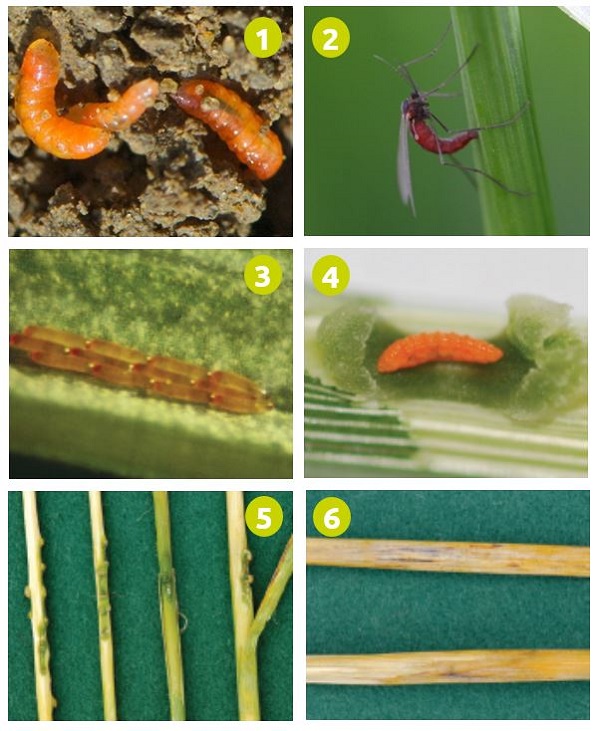- Home
- Knowledge library
- Identification and management of saddle gall midge in cereals
Identification and management of saddle gall midge in cereals
Saddle gall midge is a sporadic pest of cereals, with local epidemics occurring in some years. The pest can reduce yields and cause crops to lodge, so it is important to understand and manage risk.
Saddle gall midge life cycle and symptoms
During spring, saddle gall midge (Haplodiplosis marginata) larvae pupate in the soil (picture 1). Warm, damp soils speed up pest development and the time of adult emergence, which occurs from mid-April and lasts for up to ten weeks.
Adult midges are red and up to 5 mm long (females tend to be bigger than males). After mating, females lay blood-red eggs (up to 250) on the upper and lower surfaces of cereal and grass leaves (picture 2), arranged in rafts along the leaf veins (picture 3).
Eggs hatch within 1–2 weeks. The newly hatched larvae are white or pale orange, turning to bright orange as they mature (picture 4).
The larvae move down the leaves to feed on the stem underneath the leaf sheath, causing the formation of characteristic saddle-shaped galls or uneven contours on the stem surface (picture 5). Often covered by the leaf sheath, symptoms occur mainly on the top three internodes (picture 6), but may extend to lower nodes on poorly developed crops.
Larval feeding can result in reduced yield and gall-weakened stems may lodge.
Once larvae achieve maturity in July, they drop to the soil and overwinter until the following spring.
Cultural control options for saddle gall midge
- Introducing non-cereal break crops into the rotation may have a significant impact on the level of damage over the whole farm
- Early sowing cereals (in September) can reduce the risk of damage
- Oats can act as a trap crop, because they attract egg-laying females but few larvae survive
Biological control
Soil-inhabiting predators, such as carabid beetles, staphylinid beetles and spiders, consume larvae and may give some control.
An entomopathogenic fungus, Lecanicillium spp., can affect the larvae viability. Some evidence of control by parasitoids has been recorded in Germany.
Monitoring saddle gall midge
Soil monitoring
To help indicate when adult midges are likely to emerge, take regular soil samples and wet sieve them to reveal the pest’s developmental stage(s).
Crop monitoring
During stem extension, position traps at ear height in the crop to monitor adult midge activity.
Pheromone traps are the most effective. Yellow water traps can also be used, although correct midge identification is essential.
Pesticides
There are no pesticide label recommendations for the control of saddle gall midge in the UK.
Research shows adult midges should be the target of any approved insecticide. Once the larvae have crawled under the leaf sheath, they are more difficult to control.

Image credits: 1, 5 and 6. © Dewar Crop Protection. 2. © Harper Adams University. 3 and 4 © ADAS.

